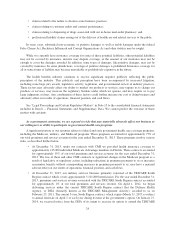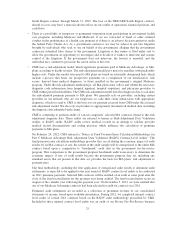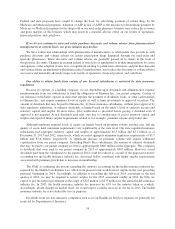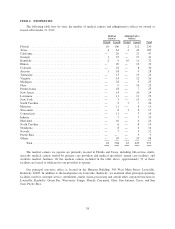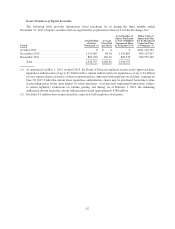Humana 2013 Annual Report Download - page 44
Download and view the complete annual report
Please find page 44 of the 2013 Humana annual report below. You can navigate through the pages in the report by either clicking on the pages listed below, or by using the keyword search tool below to find specific information within the annual report.Federal and state proposals have sought to change the basis for calculating payment of certain drugs by the
Medicare and Medicaid programs. Adoption of ASP in lieu of AWP as the measure for determining payment by
Medicare or Medicaid programs for the drugs sold in our mail-order pharmacy business may reduce the revenues
and gross margins of this business which may result in a material adverse effect on our results of operations,
financial position, and cash flows.
If we do not continue to earn and retain purchase discounts and volume rebates from pharmaceutical
manufacturers at current levels, our gross margins may decline.
We have contractual relationships with pharmaceutical manufacturers or wholesalers that provide us with
purchase discounts and volume rebates on certain prescription drugs dispensed through our mail-order and
specialty pharmacies. These discounts and volume rebates are generally passed on to clients in the form of
steeper price discounts. Changes in existing federal or state laws or regulations or in their interpretation by courts
and agencies or the adoption of new laws or regulations relating to patent term extensions, and purchase discount
and volume rebate arrangements with pharmaceutical manufacturers, may reduce the discounts or volume rebates
we receive and materially adversely impact our results of operations, financial position, and cash flows.
Our ability to obtain funds from certain of our licensed subsidiaries is restricted by state insurance
regulations.
Because we operate as a holding company, we are dependent upon dividends and administrative expense
reimbursements from our subsidiaries to fund the obligations of Humana Inc., our parent company. Certain of
our insurance subsidiaries operate in states that regulate the payment of dividends, loans, or other cash transfers
to Humana Inc., and require minimum levels of equity as well as limit investments to approved securities. The
amount of dividends that may be paid to Humana Inc. by these insurance subsidiaries, without prior approval by
state regulatory authorities, or ordinary dividends, is limited based on the entity’s level of statutory income and
statutory capital and surplus. In most states, prior notification is provided before paying a dividend even if
approval is not required. Actual dividends paid may vary due to consideration of excess statutory capital and
surplus and expected future surplus requirements related to, for example, premium volume and product mix.
Although minimum required levels of equity are largely based on premium volume, product mix, and the
quality of assets held, minimum requirements vary significantly at the state level. Our state regulated insurance
subsidiaries had aggregate statutory capital and surplus of approximately $5.5 billion and $5.1 billion as of
December 31, 2013 and 2012, respectively, which exceeded aggregate minimum regulatory requirements of $3.5
billion and $3.4 billion, respectively. A significant increase in premium volume will require additional
capitalization from our parent company. Excluding Puerto Rico subsidiaries, the amount of ordinary dividends
that may be paid to our parent company in 2014 is approximately $840 million in the aggregate. This compares
to dividends that were paid to our parent company in 2013 of approximately $967 million. However, actual
dividends paid from the subsidiaries to the parent in 2014 could be reduced as a result of the proposed statutory
accounting for the health insurance industry fee, discussed below, combined with higher surplus requirements
associated with premium growth due to increases in membership.
The NAIC is continuing discussions regarding the statutory accounting for the health insurance industry fee
required by the Health Care Reform Law which in its present form would restrict surplus in the year preceding
payment, beginning in 2014. Accordingly, in addition to recording the full-year 2014 assessment in the first
quarter of 2014, we may be required to restrict surplus for the 2015 assessment ratably in 2014. In 2014, we
expect to pay the federal government in the range of $525 million to $575 million for the annual health insurance
industry fee. In 2015, the health insurance industry fee increases by 41% for the industry taken as a whole.
Accordingly, absent changes in market share, we would expect a similar increase in our fee in 2015. The health
insurance industry fee is not deductible for tax purposes.
Dividends from our non-insurance companies such as in our Healthcare Services segment are generally not
restricted by Departments of Insurance.
34


